The somewhat sleepy town stirs. Traffic bubbles rise to the surface of some collective awareness. The heretofore tolerable August simmer matures into a boil as a flood of out-of-state plates and in-state residents rush in to establish their temporary stake within our claim. All are welcome, yes. Such is the ebb and flow of life in a college town. But dang it all, it’s a rough patch we skid across every year when the University re-swallows its fall feast of folkery.
I walk from my parking allotment over to my job most weekdays and how pleasant the early morning dinless spaces downtown can be in high summer. The occasional town truck. A few joggers. The intermittent dog leading a sleepy human along. I love summer in Chapel Hill.
And what does all this have to do with the lovely trees along our primary downtown artery? Well, not much, except I really enjoy introductory paragraphs, the challenge of taking the text off the ground and reaching a cruising altitude without the same old prattle. Every sentence a surprise. It may not be Faulkner (in fact, I’m certain it’s not), but it’ll get you out of the gate and into the fluffy clouded atmosphere of this article. Take a breath, feel free to unfasten your seat belt and move about the cabin. Let’s go look at some trees.
More Fun With Franklin Street Trees
Editor’s note: This is the third in a series on Downtown Chapel Hill trees. Parts one and two covered East Franklin Street from Columbia Street to the Post Office.
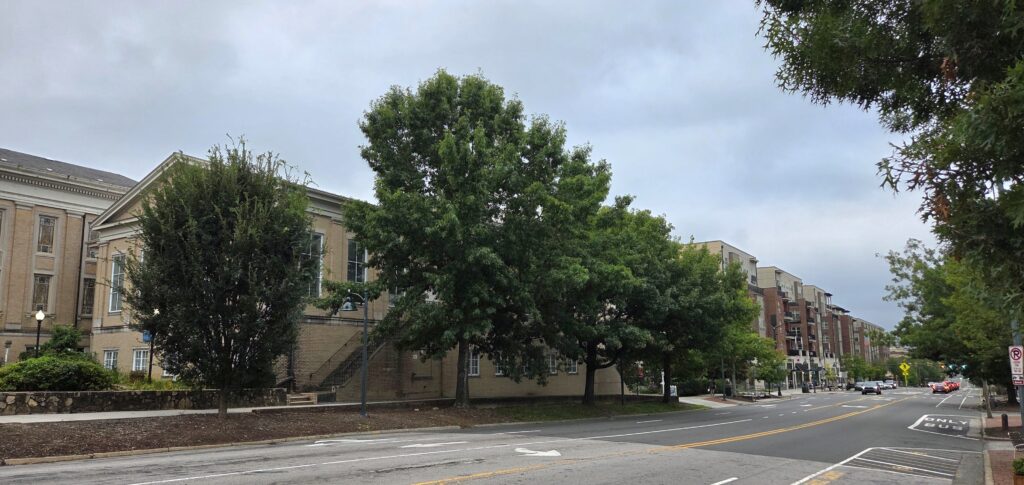
Looking west from the intersection of Columbia and Franklin Streets
The 100 block’s southside trees
The next piece of the town map we’re considering consists of West Franklin Street from the intersection with Columbia Street, moving west and downhill to the intersection with Mallette Street at the bottom. It’s a fair piece of real estate, two blocks long if you count the Church Street intersection (and why wouldn’t you, there’s a lovely stop light and crosswalk there, buildings on every corner, many of them occupied), and a decent amount of living lumber on either side. This time around, we’re going to start on the south side of the street, mainly because those are the trees I managed to get more pictures of when I took my first slow walk along this section of streetscape. Let’s take that walk again, together…
The first cohort of woody friends is the seven trees along the side of the University Baptist Church. The congregation originally met further down at the intersection of West Franklin and Church (the street conveniently named for the building) before it relocated closer to campus and made way for a Masonic Lodge.
Trees 1 & 2: Chinese pistache & Chinese elm
The first two trunks just down from the stoplight and alongside University Baptist are immediately recognizable, as we have seen them on the other side of Columbia. Chinese pistache (Pistacia chinensis) and Chinese elm (Ulmus parviflora) are commonly employed as street trees. Strong structure, interesting foliage, some fall color, the elm bark is always worth a lingering look as you slouch past on your way to this or that or the other thing.
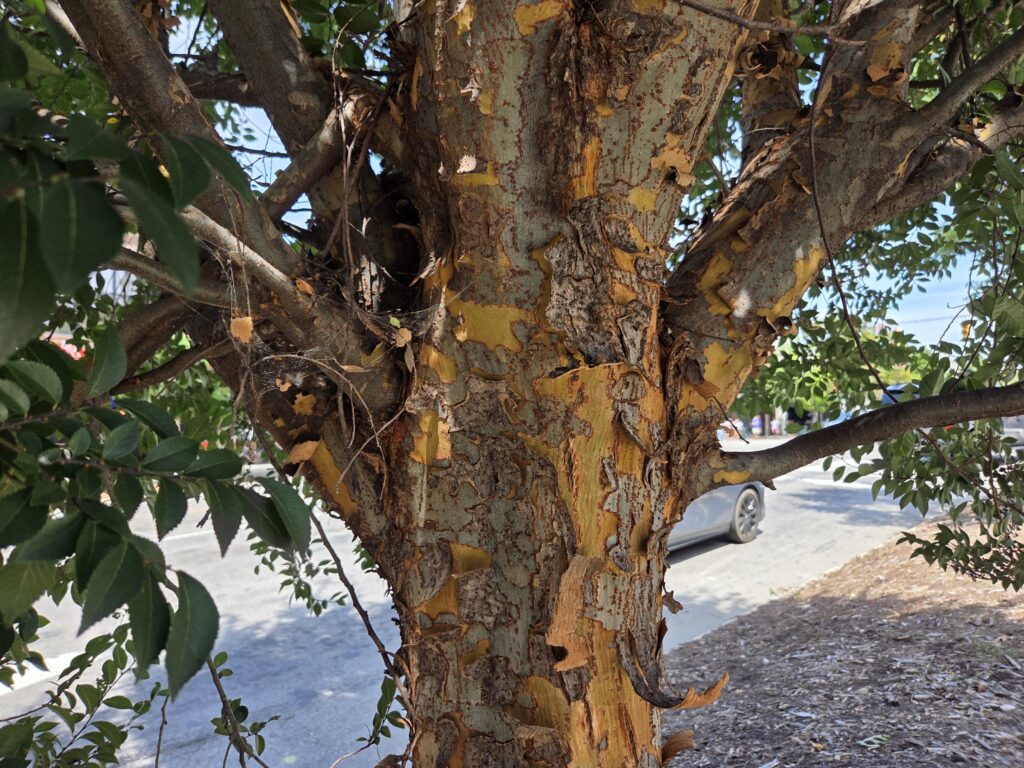
The lovely bark of the Chinese elm (Ulmus parviflora)
These two may actually hang around for a while as the surrounding hardscape is lower to the ground. There is a charming small garden on the northeast corner of the church, thus no implacable building wall to conflict with maturing canopies.
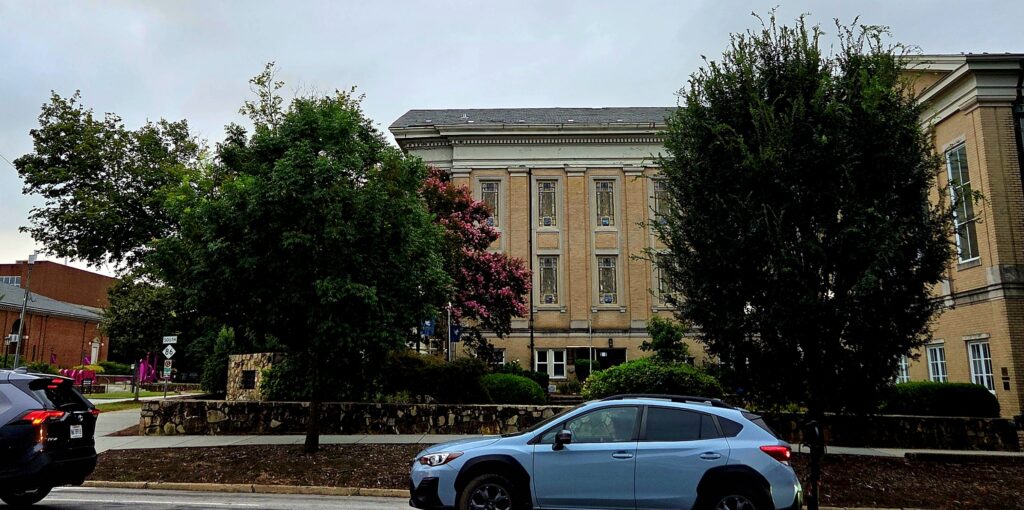
Chinese pistache (Pistacia chinensis) and Chinese elm (Ulmus parviflora) in front of University Baptist Church
Trees 3-6: Pin oaks
Strolling down the street, we continue to enjoy the shade of several pin oaks (Quercus palustris), a tried-and-true go-to for parking lots and sidewalk strips everywhere. This is a fairly nondescript member of the red oak group, with pointy leaf lobes and generous, squirrel-ready acorns. These oaks are easy to spot as they have a well-balanced form, the lower limbs leaning to ground, the upper angling up to sky and the middle third coming out nicely parallel to earth. Elliptical in profile. Along walkways and parking lots, however, the lower limbs are often removed to make way for human flow.
Margot reminds me, as ever, that some folks, including maybe you and for-sure her kin from the Appalachian Highlands and other points west, call willow oaks (Quercus phellos) pin oaks, ostensibly because the former’s leaves look like pins or pens-pronounced-pins. I remind her that they also look like willow leaves. She is nonplussed.
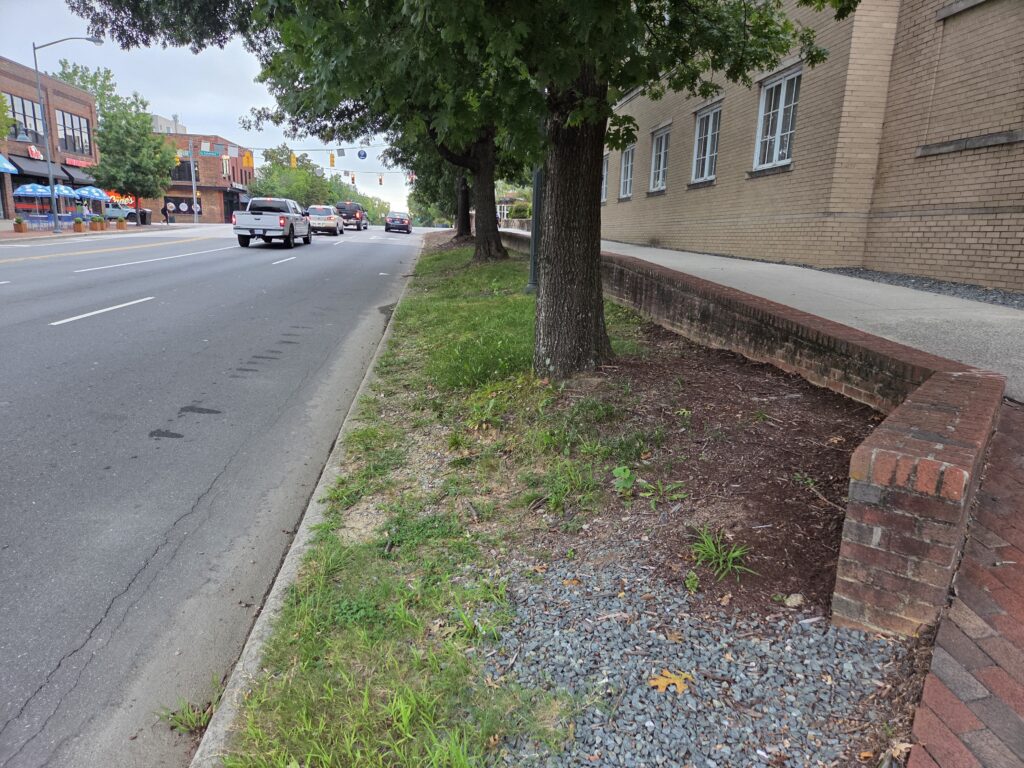
Pin oaks (Quercus palustris) all in a line with room to grow
Tree 7: Mystery maple
The last tree in this little section of downtown with something approaching enough breathing room would be the 7th tree on our walk, a small red maple. It’s likely a hybrid or a cultivar; the leaves are not quite right for a regular old red maple (Acer rubrum). Hard to say right now, but I’ll be checking back in from time to time to see if it leaves any further clues as to its identity. For now, here’s an image of the space at the base of the little tree. Yep, that’s dirt all right.
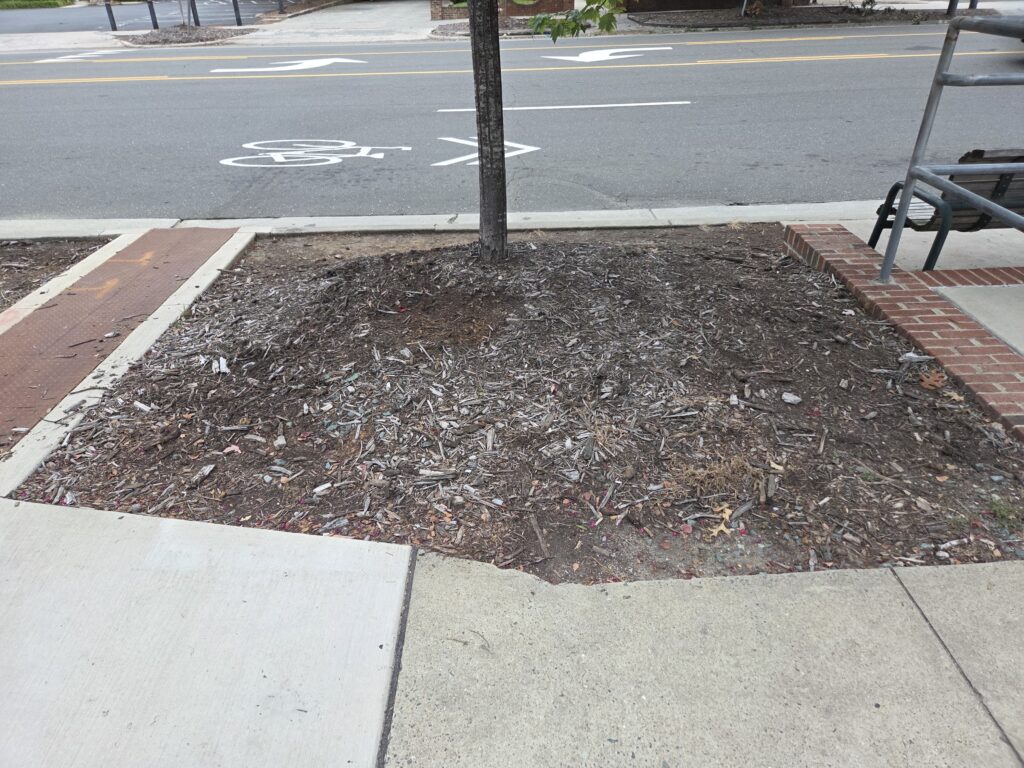
A maple, as yet unidentified
Soapbox moment #1
One note before we move along: the ground here is open. There is bare earth surrounding these trees that allows for energy to move from above. Water, air, all the good stuff all us living things need. It gladdens me to see these open islands of soil in the sea of asphalt and concrete that defines our downtown. Further along (in either direction), we see tree after tree planted less than a dozen feet from buildings. This arrangement, unavoidable it seems, at least in the short term, favors the structure and places the tree in a temporary role, something to be enjoyed until it grows past the allotted space where it may achieve intended form. The next step is some type of disfigurement of the plant to allow for its continued existence, or removal and replacement with a smaller tree. A silly cycle, but that’s the way of most urban centers. It doesn’t have to be, of course, but that’s another column.
Crossing over to the more recently constructed Carolina Square, we will finish up our run of trees on the 100 block. This pile of mixed-use concrete, brick, glass and assorted plastics does present a generous sidewalk. As someone who walks quite a bit, I’m always appreciative of wider ways. The space for outdoor gathering/seating is also a necessary amenity in a healthy downtown.
Trees 8 through 14 are all younger as this area was collapsed and rebuilt only a little while ago. The previous compilation of buildings favored a lower-rise, less-dense and more car-forward configuration along the street, with one tower back from the road and Granville hulking further back. Hiding decks and building up are the favored trends right now. With the new construction came a new delivery of trees.
Soapbox moment #2
As we head west, exposed roots disappear beneath metal grates. The openings for the trees are circles in the concrete overlain with metal perforated plates. This allows (some) water and air to pass through and presents a smooth surface for feet and wheels. But they’re ugly and will do little for the long-term health of the trees.
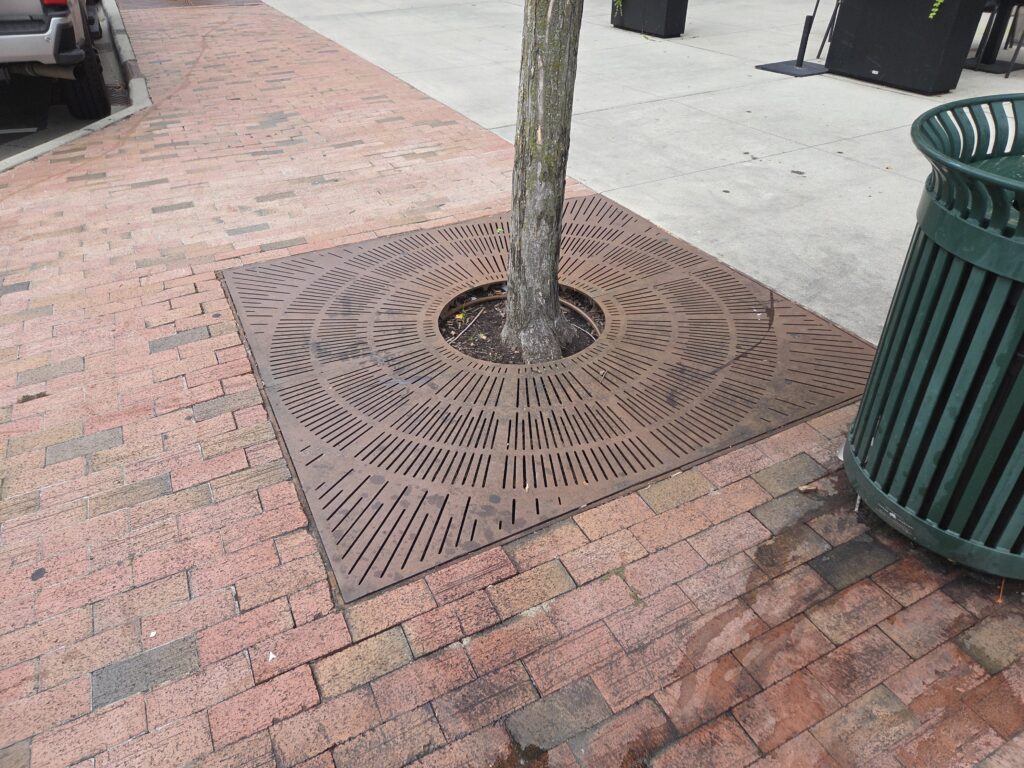
A tree jail created by pedestrian-friendly grates
Trees 8-12: More oaks
One willow oak (tree #8) and another group of pin oaks are next in line. Overall, a fairly safe assembly, like maybe there was a sale at the nursery or something. There are those who prefer a uniform collection along a streetscape, like wallpaper where the pattern repeats and you are drowsed a bit as you scan the line. Safety in repetition. Others would like a mix of species, and a sound argument for that exists when one considers what happens to your roadside planting if some pest besets a particular tree. All those elms wiped out at once is catastrophic. I believe that leaning towards the mixed assembly is the right thing to do. Strength in diversity. Right on.
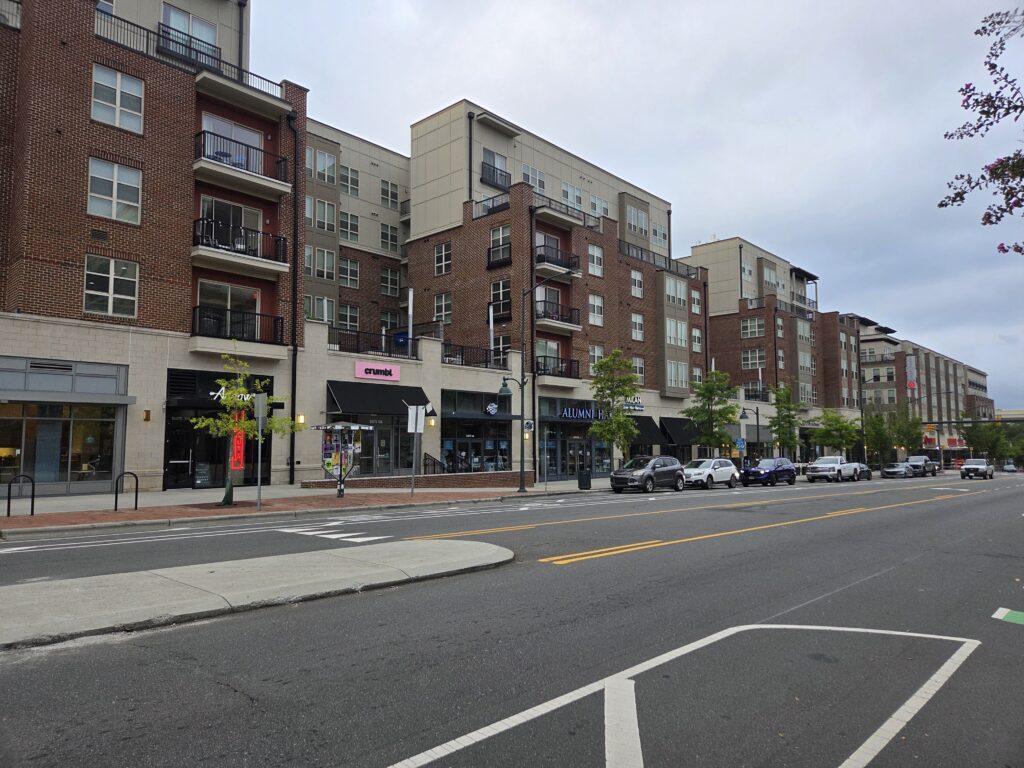
The eastern end of Carolina Square
Trees 13-16: American elm
The next four in this section are elms, likely a cultivar better suited for street life. Our American elm (Ulmus americana) is, honestly, the wrong tree to consider for a sidewalk planting. Mature specimens are 70’ tall and wide. There’s a lovely example in the Coker Arboretum, just up the street and well away from traffic and buildings. Smaller cultivated forms that are more resistant to Dutch Elm disease are recommended. ‘Frontier’ is an example that matures to about 40’ x 30’, making it a more reasonable choice for the space available. Right plant, right place.
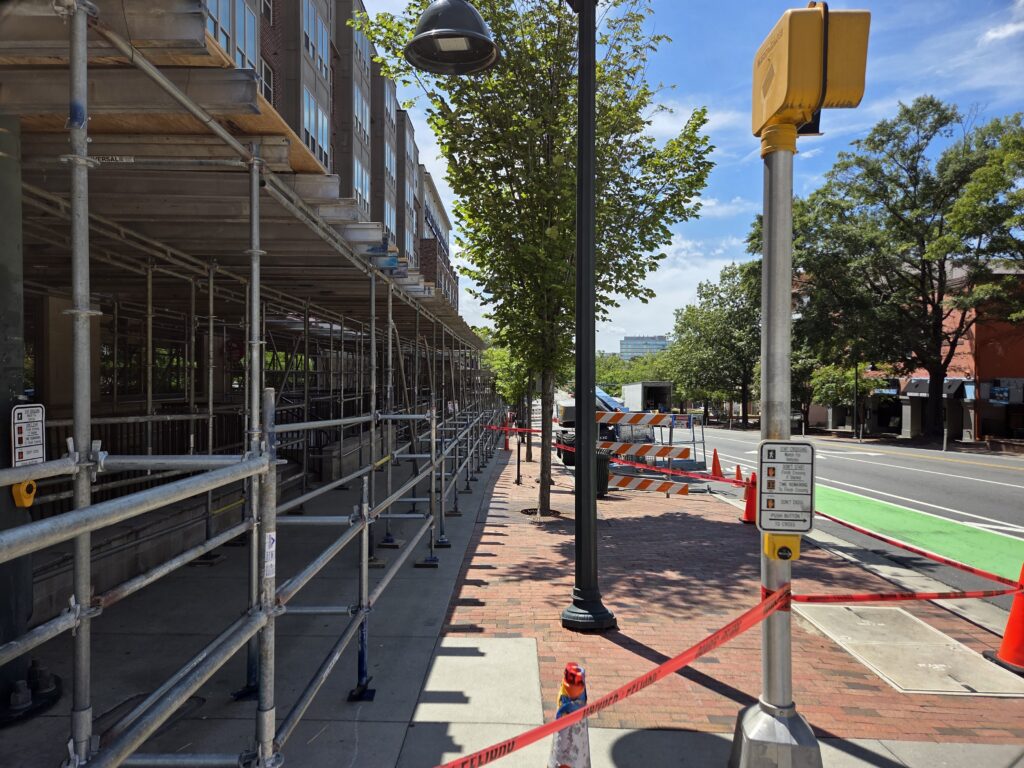
Carolina Square’s western end
Trees 17-20: Even more oaks
Another stand of three pin oaks and a willow oak. I’m not super excited about these, in all honesty, and I have to think that’s in part owing to the fact that I know that many of them will not be in their little iron-ringed prisons for very long. As a professional tender of trees and other plants, I parse out my affection and attention in greater measure to those individuals I’m inclined to believe will be around for a while. That inclination is informed by observation of site conditions. As noted, these trees are not as well looked after as they might be, so I’m keeping my emotional tinder dry.
Soapbox moment #3
Walking this route regularly, I have been afforded the opportunity to observe these plants over time. Trees will let you know when they are unwell; we all have seen this. Dropping leaves early in the season, limbs dying back or not leafing out in spring, poor flower/fruit production and slower than normal growth are all symptoms of stress. These trees are experiencing some dieback that may or may not continue. We shall see, as they say. For now, we can note the dead and upcurved branch ends on several of the trees and the paler than normal leaf color.
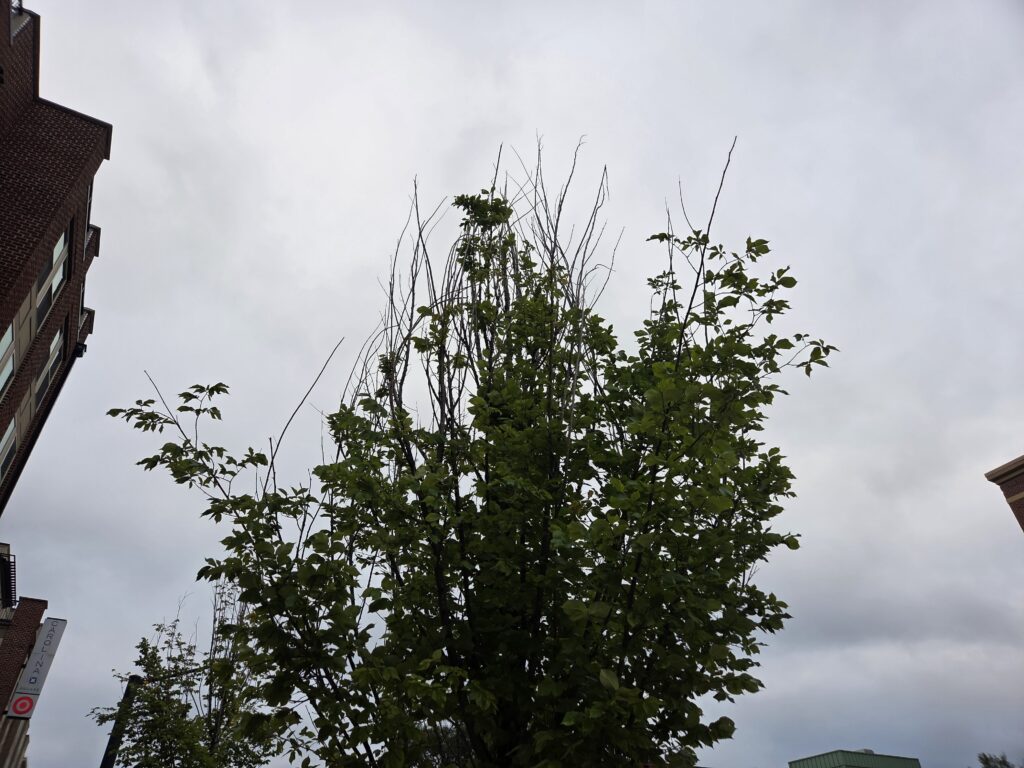
This stressed-out street tree is (probably) an elm
Trees 21: Pin oak
A notable exception is the final tree on the block—a lovely willow oak, one of the older ones on the street—in front of the Panera at the corner of Mallette and West Franklin. Here we see the return of the open planting plan, a bit more breathing room, and a tree that is showing up and growing beautifully. (Margot’s pretty sure she grabbed onto this mighty oak more than once back when the restaurant was a Hardee’s and there was a very popular yet short-lived roller-skate rental business uptown. ‘You could achieve alarming velocity going down that small hill and after that tree there was nothing to slow your roll before hitting—physically or metaphorically—the cross street.’)
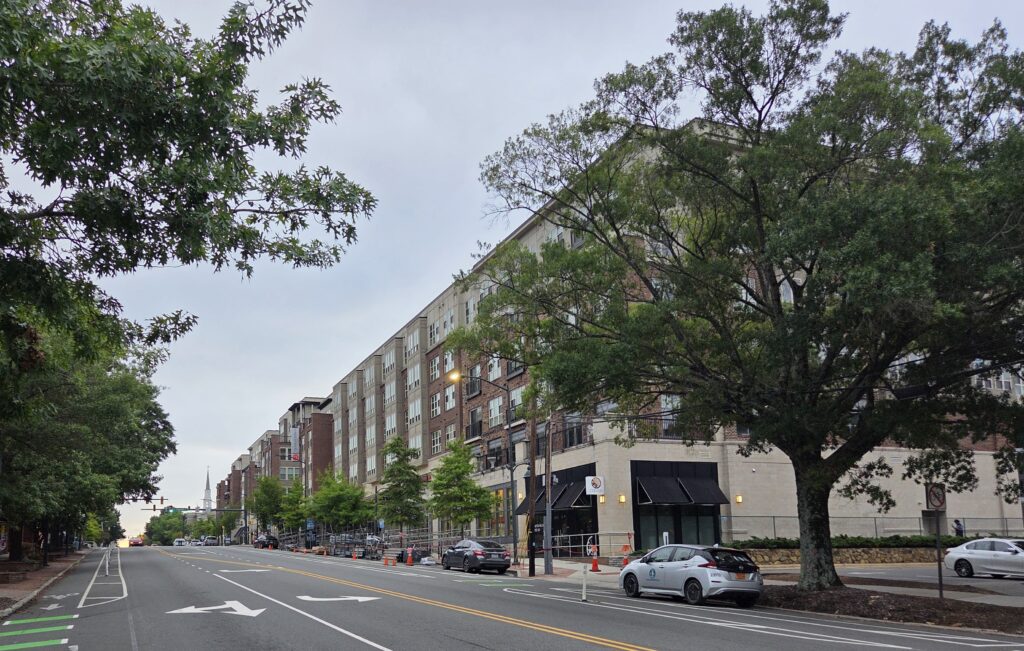
A healthy pin oak marks the end of the 200 block
Thanks for taking this little stroll with me, folks. Next month I’ll be talking a bit about how best to identify the trees around you. It’s a really awesome superpower! And I trust you’ll join me in November when we cross the street and have a look at the other side.
All photos by Geoffrey Neal
Geoffrey Neal is the director of the Cullowhee Native Plant Conference. You can see more of his photography at @soapyair and @gffry. Margot Lester is a certified interpretive naturalist and a writer and editor at The Word Factory. You can read her column on vultures here.

About the name: A refugium (ri-fyü-jē-em) is a safe space, a place to shelter, and – more formally – an area in which a population of organisms can survive through a period of unfavorable conditions or crisis. We intend this column to inspire you to seek inspiration and refuge in nature, particularly at the Arboretum!

